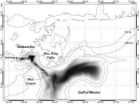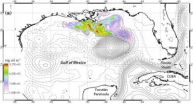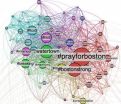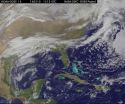(Press-News.org) Dr. Jason Jolliff is an oceanographer with the U.S. Naval Research Laboratory (NRL). "The emphasis here," he says, "is on developing models of the ocean environment to help the naval warfighter." His most recent paper, published in Ocean Modeling (March 2014), shows NRL can also forecast where oil will go following a major spill.
"If you're going to do forecasting," he says, "you have to get the ocean circulation correct. It's fundamental to all else." Jolliff plugged the distribution of surface oil following the 2010 Deepwater Horizon oil spill—when it was still well offshore—into a powerful NRL forecasting tool. He accurately predicted what would happen to the oil; in particular, the processes that made inevitable its landfall on Louisiana shorelines fully four days later.
Jolliff's second key point is, "When we look at oceanographic problems, we have to understand the scales of time and space we're dealing with." In 2010, there was concern about oil washing up on Florida beaches. But oil does evaporate and degrade; so knowing how far the oil will go over what period of time helps predict which beaches are at most risk.
Jolliff is part of a team developing a tool called Bio-Optical Forecasting (BioCast). "We're developing this framework where you can combine satellite images, that give you an estimate of what is in the ocean, with ocean circulation models." BioCast calculates "how those materials will ultimately be transported and dispersed."
Jolliff is interested in how "tracers"—like plankton or nitrate distribution—change water clarity. "That will help the Navy predict ocean optical properties." Divers need good visibility, as do airborne platforms that use electro-optics to "look" for mines in shallow waters. "But the general knowledge that we gain can be applied to a very wide range of forecasting problems, including contaminant distribution and oil spill response."
Jolliff validated NRL's capability for future operations by applying integrated forecasting to the Deepwater Horizon oil spill. He describes two sets of experiments: one at a local scale, focusing on currents near Louisiana; the second at a mesoscale, looking at the entire Gulf of Mexico.
Local scale: predicting where shoreline oil would be worst
Using satellite images from May 11, 2010—which show oil slicks still well away from shore—Jolliff forecast how oil would move over the next 96 hours. He predicted oil would make a substantial landfall on the Louisiana coast, west of the Mississippi River Delta, on May 14. "The forecast was qualitatively accurate," he says. "That's precisely what happened."
Jolliff uses the NRL tool, Coupled Ocean-Atmosphere Mesoscale Prediction System (COAMPS®). "[COAMPS] was designed to provide a direct forecast of oceanographic and atmospheric variables, things like surface temperature, surface humidity, sea surface temperature, current speeds, and atmospheric visibility."
With forecasts of how water is moving from COAMPS, Jolliff predicts how a tracer will be transported through that system using BioCast. With a tracer like surface chlorophyll, which indicates phytoplankton abundance, he might forecast water clarity for a naval operations environment. By using oil from a well-documented spill as a tracer, Jolliff validated how the models work together.
"One of the things we can do at NRL is we can start to explore areas that weren't necessarily thought of when [COAMPS] was designed," says Jolliff.
Following Deepwater Horizon's blowout, "the main surface aggregation of oil was offshore." For the oil to reach shorelines, surface water from the deep ocean would have to carry it in and exchange with coastal waters.
"What we find, generally," says Jolliff, "is that the water near shore tends to stay near shore, and the water off shore tends to stay off shore. So in order to forecast if this oil is going to impact some coastal area, you have to know where this water mass exchange is going to take place." With COAMPS, Jolliff was able to explain the water mass exchange that led to the severe oiling in Louisiana.
Where the Mississippi River Delta landmass protrudes out into the Gulf of Mexico, coastal currents can mix with offshore surface waters. "Oil that is initially offshore, it'll come near shore and bump up against the Mississippi River Delta. And then it gets whipped around and swept into this coastal current."
Additionally, there's an unusually deep feature on the ocean floor to the southwest of the Delta, called the Mississippi Canyon. The irregular ocean depths, or bathymetry, between the Delta and the Canyon; prevailing winds; and fresh water that drains from the Delta all contribute to water mass exchange.
To show oil would be concentrated where currents converge, and dispersed where currents diverge, "We had specific buoyancy restoring term in the model that would bring oil back to the surface." He was able to account for the tendency of oil, pulled under by currents, to rise back to the surface-critical to forecasting material transport. A three-dimensional framework made these zones of divergence and convergence easier to identify than in 2010 (Eulerian versus Lagrangian). (A future model that sought to include subsurface oil in the initial inputs would need a more complex accounting of how hydrocarbons interact with seawater and chemical dispersants.)
Jolliff doesn't compare his predictions to what federal agencies made at the time, because they were continuously updating their simulations. "The take home message is that COAMPS was able to forecast the atmospheric and oceanographic conditions that made that funnel [of water mass exchange] operate. And so what was happening in the model then happened in reality."
Mesoscale: why the oil spill didn't hurt Florida beaches
Next, Jolliff sought to explain what happened to oil over a longer time period and wider region. Unlike the first set of experiments, "We're doing what's called a 'hindcast'; and that's every 12 hours, the ocean model is assimilating information from satellites to correct deviations from those observations."
Except for two gaps, land hems in the Gulf of Mexico. As a result, ocean current tends to flow in through a gap between the Yucatan and Cuba, and then into a forceful clockwise Loop Current that turns toward the southeast.
Most of the time, the Gulf's Loop Current is able to squeeze out through the Florida Straits. "But it's unstable," says Jolliff, "so with some frequency, this big loop detaches and forms this sort of closed, clockwise circulation of water—what oceanographers call a mesoscale eddy." And with the hindcasts, Jolliff observed exactly that.
"You see that the Loop Current itself pinched off to form an eddy." This fortuitous event prevented the current from carrying aggregated surface oil to Key West and eastern Florida beaches, like Miami. "This emphasizes the point that the only way you'd know that is to forecast the ocean circulation."
In addition to understanding regional currents, time scale is also very important. For the 96-hour forecast, Jolliff could assume oil was an inert tracer. But over time, oil "weathers"—evaporating and biodegrading. Jolliff accounted for weathering in the mesoscale by assuming a rate of decay. He acknowledges this oversimplifies the true chemical properties of oil, and could be improved in a future model; but in 2010, most forecasters didn't account for weathering at all.
Even if the current had carried oil to Florida, the damage likely wouldn't have been severe. "What we see is that it takes more than 10 days for that surface oil to finally get entrained into the Loop Current. Enough time has elapsed that these materials are now significantly degraded."
NRL on the front line: improving ocean models supports readiness
While Jolliff tested NRL's operational capability against the Deepwater Horizon oil spill, he could make similar forecasts for a spill anywhere in the world. "What's very powerful about COAMPS," he says, "is we can take models that are much larger in scale, and we can zoom in to these local areas."
Going forward, he'll focus on integrating more cross-interacting variables directly into COAMPS to give naval operators a more accurate and complete forecast. "In any complicated system," he says, "you're going to have various feedbacks. The ocean and the atmosphere are constantly exchanging energy." By bringing the tracer directly into COAMPS, instead of using BioCast to perform transport calculations separately from COAMPS, he could see if materials in the ocean impact air-sea interactions.
He and NRL colleague Dr. Travis Smith are researching the biological, chemical, and physical properties of key tracers. "As you go out to longer and longer time scales, you have to bring more and more of inherent reactivity of these materials into your calculations: things like phytoplankton growth, settling of particles." Incorporating these properties, similar to what he did with the decay constant for oil, improves forecasts of ocean optics.
"The tools we've developed here at NRL are state of the art, without question," he says.
INFORMATION: END
NRL models Deepwater Horizon oil spill
Shows capability to forecast water clarity during naval missions
2014-03-18
ELSE PRESS RELEASES FROM THIS DATE:
Canadian drinking-age laws have significant effect on deaths among young males
2014-03-18
A recent study by a University of Northern British Columbia-based scientist associated with the UBC Faculty of Medicine and UNBC's Northern Medical Program demonstrates that Canada's drinking-age laws have a significant effect on youth mortality.
The study was published yesterday in the international journal Drug and Alcohol Dependence. In it, Dr. Russell Callaghan writes that when compared to Canadian males slightly younger than the minimum legal drinking age, young men who are just older than the drinking age have significant and abrupt increases in mortality, especially ...
Global food trade can alleviate water scarcity
2014-03-18
Trading food involves the trade of virtually embedded water used for production, and the amount of that water depends heavily on the climatic conditions in the production region: It takes, for instance, 2.700 liters of water to produce 1 kilo of cereals in Morocco, while the same kilo produced in Germany uses up only 520 liters. Analyzing the impact of trade on local water scarcity, our scientists found that it is not the amount of water used that counts most, but the origin of the water. While parts of India or the Middle East alleviate their water scarcity through importing ...
Using big data to identify triple-negative breast, oropharyngeal, and lung cancers
2014-03-18
Researchers at Case Western Reserve University and colleagues used "big data" analytics to predict if a patient is suffering from aggressive triple-negative breast cancer, slower-moving cancers or non-cancerous lesions with 95 percent accuracy.
If the tiny patterns they found in magnetic resonance images prove consistent in further studies, the technique may enable doctors to use an MRI scan to diagnose more aggressive cancers earlier and fast track these patients for therapy. Their work is published online in the journal Radiology at http://pubs.rsna.org/doi/full/10.1148/radiol.14131384. ...
Strongest evidence yet of 2 distinct human cognitive systems
2014-03-18
BUFFALO. N.Y. — Cognitive scientists may have produced the strongest evidence yet that humans have separate and distinct cognitive systems with which they can categorize, classify, and conceptualize their worlds.
"Our finding that there are distinct, discrete systems has implications for the fields of child development and cognitive aging," says lead researcher, cognitive psychologist J. David Smith, PhD, of the University at Buffalo.
"These distinct systems may have different developmental courses as the cortex matures," he says, "meaning that children may categorize ...
Ipilimumab in advanced melanoma: Added benefit for non-pretreated patients not proven
2014-03-18
The German Institute for Quality and Efficiency in Health Care (IQWiG) already assessed the added benefit of ipilimumab in advanced melanoma in 2012. A considerable added benefit was found for patients who had already received previous treatment. In the new dossier compiled by the drug manufacturer, the drug was now compared with the appropriate comparator therapy dacarbazine specified by the Federal Joint Committee (G-BA) also for non-pretreated patients.
Again, the manufacturer claimed a noticeable gain in survival time and thus an added benefit. This time, IQWiG did ...
Scientists using UNH detector illuminate cause of sun's 'perfect storm'
2014-03-18
DURHAM, NH –– In a paper published today in Nature Communications, an international team of scientists, including three from the University of New Hampshire's Space Science Center, uncovers the origin and cause of an extreme space weather event that occurred on July 22, 2012 at the sun and generated the fastest solar wind speed ever recorded directly by a solar wind instrument.
The formation of the rare, powerful storm showed striking, novel features that were detected by a UNH-built instrument on board NASA's twin-satellite Solar TErrestrial RElations Observatory (STEREO) ...
New airborne GPS technology for weather conditions takes flight
2014-03-18
GPS technology has broadly advanced science and society's ability to pinpoint precise information, from driving directions to tracking ground motions during earthquakes. A new technique led by a researcher at Scripps Institution of Oceanography at UC San Diego stands to improve weather models and hurricane forecasting by detecting precise conditions in the atmosphere through a new GPS system aboard airplanes.
The first demonstration of the technique, detailed in the journal Geophysical Research Letters (GRL), is pushing the project's leaders toward a goal of broadly implementing ...
Pitt study challenges accepted sepsis treatment
2014-03-18
PITTSBURGH, Mar.14, 2014 – A structured, standardized approach to diagnose and treat sepsis in its early stages did not change survival chances for people who develop this deadly condition, according to a national, randomized clinical trial led by experts at the University of Pittsburgh School of Medicine.
Their findings, available online and published in the May 1 edition of the New England Journal of Medicine, could change the way sepsis is diagnosed and treated. Each year, sepsis, the body's response to severe infections, kills more people than breast cancer, prostate ...
Hold that RT: Much misinformation tweeted after 2013 Boston Marathon bombing
2014-03-18
It takes only a fraction of a second to hit the retweet button on Twitter. But if thousands of people all retweet at once, a piece of information 140 characters long can go viral almost instantly in today's Internet landscape.
If that information is incorrect, especially in a crisis, it's hard for the social media community to gain control and push out accurate information, new research shows.
University of Washington researchers have found that misinformation spread widely on Twitter after the 2013 Boston Marathon bombing despite efforts by users to correct rumors ...
Satellite movie shows a Mid-Atlantic St. Patrick's Day snow
2014-03-18
The green of St. Patrick's Day in the Mid-Atlantic was covered by white snow as a result of a late winter snow storm. The covering of the green was captured in a movie made at NASA using NOAA's GOES satellite data.
The winter storm dropped snow totals from 6" to 12" of snow from Baltimore, Md. to Richmond, Va. The storm arrived during the evening of March 16 and continued through March 17. As of 1 p.m. EDT, light bands of snow continued to fall throughout the Washington, D.C. area.
NOAA's GOES-East satellite captured the path the storm took through the Mid-Atlantic ...
LAST 30 PRESS RELEASES:
Numbers in our sights affect how we perceive space
SIMJ announces global collaborative book project in commemoration of its 75th anniversary
Air pollution exposure and birth weight
Obstructive sleep apnea risk and mental health conditions among older adults
How talking slows eye movements behind the wheel
The Ceramic Society of Japan’s Oxoate Ceramics Research Association launches new international book project
Heart-brain connection: international study reveals the role of the vagus nerve in keeping the heart young
Researchers identify Rb1 as a predictive biomarker for a new therapeutic strategy in some breast cancers
Survey reveals ethical gaps slowing AI adoption in pediatric surgery
Stimulant ADHD medications work differently than thought
AI overestimates how smart people are, according to HSE economists
HSE researchers create genome-wide map of quadruplexes
Scientists boost cell "powerhouses" to burn more calories
Automatic label checking: The missing step in making reliable medical AI
Low daily alcohol intake linked to 50% heightened mouth cancer risk in India
American Meteorological Society announces Rick Spinrad as 2026 President-Elect
Biomass-based carbon capture spotlighted in newly released global climate webinar recording
Illuminating invisible nano pollutants: advanced bioimaging tracks the full journey of emerging nanoscale contaminants in living systems
How does age affect recovery from spinal cord injury?
Novel AI tool offers prognosis for patients with head and neck cancer
Fathers’ microplastic exposure tied to their children’s metabolic problems
Research validates laboratory model for studying high-grade serous ovarian cancer
SIR 2026 delivers transformative breakthroughs in minimally invasive medicine to improve patient care
Stem Cell Reports most downloaded papers of 2025 highlight the breadth and impact of stem cell research
Oxford-led study estimates NHS spends around 3% of its primary and secondary care budget on the health impacts of heat and cold in England
A researcher’s long quest leads to a smart composite breakthrough
Urban wild bees act as “microbial sensors” of city health.
New study finds where you live affects recovery after a hip fracture
Forecasting the impact of fully automated vehicle adoption on US road traffic injuries
Alcohol-related hospitalizations from 2016 to 2022
[Press-News.org] NRL models Deepwater Horizon oil spillShows capability to forecast water clarity during naval missions






